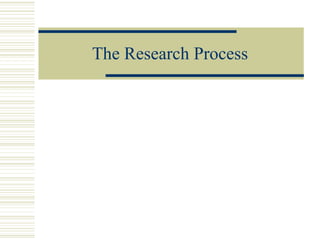
The Research Process.ppt
- 3. Purposes of Research Exploration gaining some familiarity with a topic, discovering some of its main dimensions, and possibly planning more structured research Description Census Bureau’s report on number of Ethiopians Political poll predicting who will win an election Anthropologist’s ethnographic account of a preliterate tribe Explanation Take it one step further
- 4. Research ‘Musts’ Problem must be clearly recognized Determine information already available and what further information is required, as well as the best approach for obtaining it Obtain and assess information objectively to help inform the decision
- 5. ‘Six’ Phases of Research 1. Problem definition 2. Literature review 3. Selection of research design, subjects, and data collection techniques 4. Data gathering 5. Data processing and analysis 6. Implications, Conclusions, and Recommendations
- 6. Problem Definition Describe broader context (background) State the objectives or purposes Inform reader about the scope of the study, including defining any terms, limitations, or restrictions Reduces potential criticisms State the hypothesis (es)
- 7. Literature Review Gives theoretical rationale of problem being studied, what research has been done and how it relates to the problem Helpful to divide the literature into sub-topics for ease of reading Quality of literature should be assessed Be sure to include well respected ‘individuals’ in the research area (if they exist)
- 8. Selection of Research Design The research design indicates the steps that will need to be taken and the sequence they will occur Each design can rely on one or more data collection technique Assess reliability and validity Critical consideration in determining methodology is the selection of subjects
- 9. Data Gathering Must pretest Design the sampling scheme Questionnaires must be coded
- 10. Data processing and analysis Describe demographics of the data Compare behavior (if applicable) Choose appropriate statistical technique (if applicable) Look for patterns in data (if applicable)
- 11. Interpreting the Results Make sure to consider the audience Discuss implications for the population of interest and future research
- 12. Operational Definitions Variables first defined by conceptual definitions that explain the concept the variable is trying to capture Variables then defined by operational definitions which are definitions for how variable will be measured
- 13. Language of Sampling Population: entire collection of people/things Parameter: # that results from measuring all units in population Sampling frame: specific data from which sample is drawn Unit of analysis: type of object of interest Sample: a subset of some of the units in the population Statistic: # that results from measuring all units in the sample
- 14. Unit of Analysis Major entity you are analyzing in your study It is the type of object that makes up each data point Individuals Artifacts (books, photos, newspapers) Geographical units Social interactions
- 15. Unit of Analysis Error In some studies people are allocated in groups, rather than individually. When this is done, the unit of allocation is different from the unit of analysis (usually). This is sometimes called a unit of analysis error. It can result in studies having narrower confidence intervals and receiving more weight than is appropriate.
- 16. Independent and Dependent Variables independent variable is what is manipulated a treatment or program or cause ‘Factor’ dependent variable is what is affected by the independent variable effects or outcomes ‘Measure’
- 17. Research Design and Methodology In general, a research design is like a blueprint for the research. Research Methodology concerns how the design is implemented, how the research is carried out.
- 18. A few designs Cross-Sectional Design Longitudinal Design Time Series Design Panel Design
- 19. Cross-Sectional Design A cross-sectional design is used for research that collects data on relevant variables one time only from a variety of people, subjects, or phenomena. A cross-sectional designs provides a snapshot of the variables included in the study, at one particular point in time. Cross-sectional designs generally use survey techniques to gather data, for example, the Census.
- 20. Advantages: data on many variables, data from a large number of subjects, data from dispersed subjects, data on attitudes and behaviors, good for exploratory research, generates hypotheses for future research, data useful to many different researchers Disadvantages: increased chances of error, increased cost with more subjects and each location, cannot measure change, cannot establish cause and effect, no control of independent variable, difficult to rule out rival hypotheses, static
- 21. Longitudinal Designs A longitudinal design collects data over long periods of time. Measurements are taken on each variable over two or more distinct time periods. This allows the researcher to measure change in variables over time.
- 22. Time Series Design A Time Series Design collects data on the same variable at regular intervals in the form of aggregate measures of a population. Time series designs are useful for: establishing a baseline measure describing changes over time keeping track of trends forecasting future (short term) trends
- 23. Advantages: data easy to collect, easy to present in graphs, easy to interpret, can forecast short term trends Disadvantages: data collection method may change over time, difficult to show more than one variable at a time, needs qualitative research to explain fluctuations, assumes present trends will continue unchanged
- 24. Panel Designs Panel Designs collect repeated measurements from the same people or subjects over time. Panel studies reveal changes at the individual level. Advantages: reveals individual level changes, establishes time order of variables, can show how relationships emerge Disadvantages: difficult to obtain initial sample of subjects, difficult to keep the same subjects over time, repeated measures may influence subjects behavior
